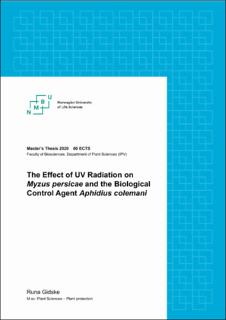| dc.contributor.advisor | Johansen, Nina Svae | |
| dc.contributor.advisor | Suthaparan, Aruppillai | |
| dc.contributor.author | Gidske, Runa | |
| dc.date.accessioned | 2020-11-10T11:30:00Z | |
| dc.date.available | 2020-11-10T11:30:00Z | |
| dc.date.issued | 2020 | |
| dc.identifier.uri | https://hdl.handle.net/11250/2687089 | |
| dc.description.abstract | Greenhouse light technologies are advancing, giving new opportunities in pest management such as UV treatments against pathogenic fungi. Little is known about how these methods affect other relevant organisms in protected cropping systems, such as arthropod pests and biological control agents. This study investigated the effect of broad-spectrum UV (lpeak=313 nm) and UV-C (lpeak=254 nm) on Myzus persicae, and the aphid parasitoid, Aphidius colemani. Two independent experiments were conducted with M. persicae on leaf disks and with M. persicae with and without presence of A. colemani on whole plants of sweet pepper. In the leaf disk experiment broad-spectrum UV (0,314 kJ/m2/day) and UV-C (0,169 and 0,371 kJ/m2/day) treatments were given. UV-C (0,149 and 0,321 kJ/m2/day) treatments were given in the experiment on whole plants. Significant effects of night-time UV treatments were seen on the lifespan (p=0,000) and development (p=0,000) of M. persicae on leaf disks. Average lifespan of M. persicae nymphs exposed to UV irradiation ranged from 4,5-7,2 days, compared to 36,7 days in the non-irradiated control. 88-100% of the UV irradiated aphid nymphs died before reaching the imaginal stage. On whole plants a significant effect of UV-C treatments was seen on M. persicae population size (p=0,006). After five weeks this study found a 91-90% reduction of aphids on leaves exposed to a higher dose of UV-C, compared to the non-irradiated control. This reduction was similar with biological control alone. UV-C treatments did also affect the spatial distribution of aphids on the plants (p=0,000). An average of 74-77% of aphids sat on the adaxial leaf side in the higher UV-C dose, but no difference was seen on spatial distribution in the non-irradiated controls. No effects of UV-treatments were seen on the parasitism rate by A. colemani. Due to high variation and lower averages than in the control, it is still reason to suspect that night-time UV treatments reduce the success of biological control. This study shows that UV treatments can reduce the pest pressure of M. persicae, but it is not believed to control established populations to under the economic threshold. Further investigation is needed of how biological control with A. colemani can be facilitated where UV treatments are in use. | en_US |
| dc.description.sponsorship | This Master’s project was made possible with economical support from the Norwegian Growers’ Association (Norsk Gartnerforbund), UMB’s Research Fund and a collaborative project between Cornell University, Norwegian Institute for Bioeconomy Research (NIBIO) and others, financed by USDA-OREI. | en_US |
| dc.language.iso | eng | en_US |
| dc.publisher | Norwegian University of Life Sciences, Ås | en_US |
| dc.rights | Attribution-NonCommercial-NoDerivatives 4.0 Internasjonal | * |
| dc.rights.uri | http://creativecommons.org/licenses/by-nc-nd/4.0/deed.no | * |
| dc.subject | Myzus persicae | en_US |
| dc.subject | Aphidius colemani | en_US |
| dc.subject | UV-C | en_US |
| dc.subject | Biological control | en_US |
| dc.subject | Broad-spectrum UV | en_US |
| dc.subject | UV | en_US |
| dc.title | The Effect of UV Radiation on Myzus persicae and the Biological Control Agent Aphidius colemani | en_US |
| dc.type | Master thesis | en_US |
| dc.description.version | submittedVersion | en_US |
| dc.subject.nsi | VDP::Landbruks- og Fiskerifag: 900 | en_US |
| dc.source.pagenumber | 45 | en_US |
| dc.description.localcode | M-PV | en_US |

